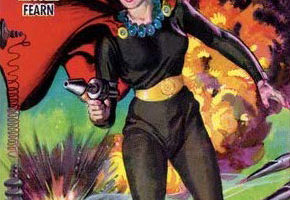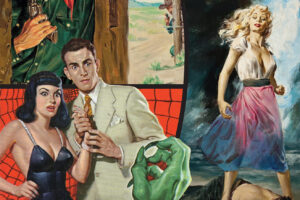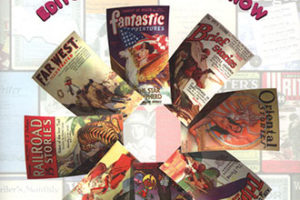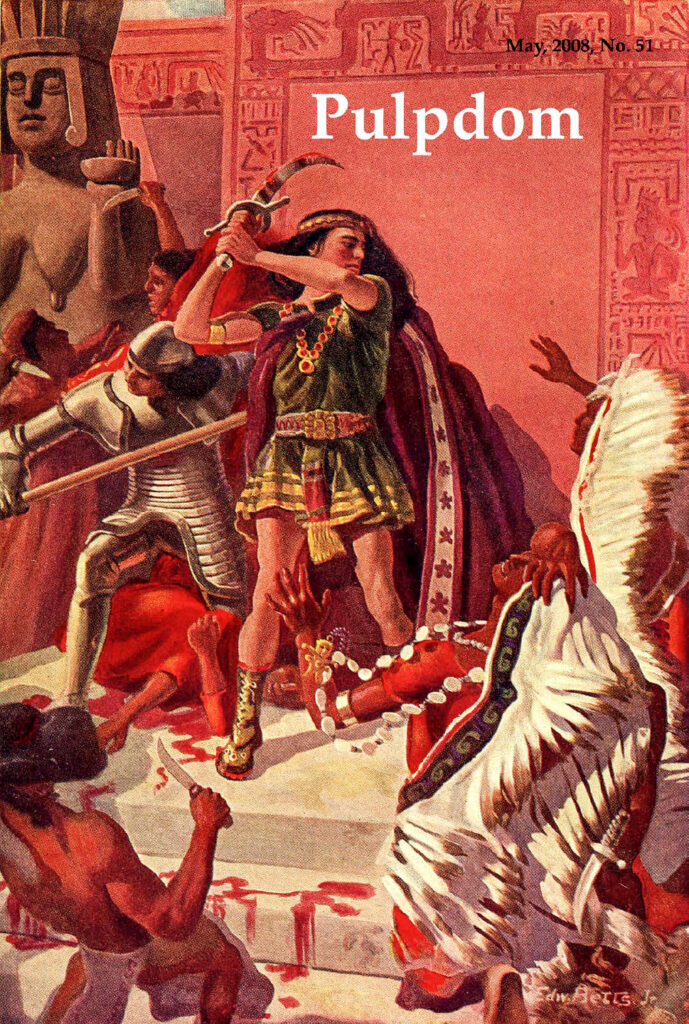 As with other issues, these are all 28 to 32 pages, side-stapled, reprinting early pulp fiction, with various non-fiction articles and artwork also focused on the early pulps. In some issues, the non-fiction works are more prominent, in some cases pushing out any fiction reprints, and for me, these are almost more interesting. All have color covers and often interior color as well.
As with other issues, these are all 28 to 32 pages, side-stapled, reprinting early pulp fiction, with various non-fiction articles and artwork also focused on the early pulps. In some issues, the non-fiction works are more prominent, in some cases pushing out any fiction reprints, and for me, these are almost more interesting. All have color covers and often interior color as well.
With this fanzine, you also need to pay attention to letters, editorials, and the like, as there is useful and interesting information there, as well as in the more formal articles. Often these are follow-up and additions to articles and items from prior issues.
■ #51 (May 2008): The cover is from Prince Izon: A Romance of the Grand Canyon, a lost-race book from 1910 that has a group of Aztecs fleeing Cortez for the Grand Canyon. Mike Taylor continues his series on The Argosy, now up to 1918, with a focus on fantastical works. Several of these have been reprinted. I hope we can get reprints of others at some point. I almost want to make a list. We get many color covers reproduced with the writeups. There is a sidebar on Francis Stevens‘ “Citadel of Fear,” which I’ve reviewed here, as well as an article on just the author.
We get short reviews of “The Island of Regeneration” (1909) by C.T. Brady, and “Sea Lure” (1926) and “The Sun Test” (1927) by Richard Barry. From Mel Madel we get “The Rise and Fall of James Branch Cabell,” along with a bibliography of him. While I’m aware of him and have some of his works, I’ve never read him.
■ #52 (August 2008): We get a cover from a 1919 issue of Argosy, which ties to Mike Taylor’s article on The Argosy Weekly from 1919. Again, we get lots of color covers and a focus on the fantastical works that year. We get a fiction reprint, Robert W. Sneedon‘s “The Nameless Thing” from the July 12, 1919, issue. This story would fit right in with Weird Tales. Finally, we have “1938: A Year Full of Action” by Vince Nowell Sr. that focuses on several things that happened that year, such as the release of Snow White and the Seven Dwarfs, Orson Welles‘ War of the Worlds radio broadcast and more.
■ #53 (November 2008): This time we get an Arabic cover tied to an Otis Adelbert Kline story, “The Fang of Amm Jemel” (Argosy, 1935) reprinted here. There is an article on both Kline and Ralph Milne Farley as authors who follow in the footsteps of Edgar Rice Burroughs. We get lots of cover artwork, as well as reprints of the one-page bio/write-ups of authors taken from The Argosy. There is also a brief article on scholar Everett F. Bleiler‘s writings on both Kline and Farley. There is a review of “Satans on Saturn” by Kline and E. Hoffmann Price (Argosy, 1940). Sadly, there are no reprints from Farley though.
■ #54 (April 2009): Under a nice cover of Robur‘s Albatross airship, we get several pieces. Mike Taylor, joined by Caz, now looks at The All-Story from 1905-07. The focus is on fantastical works and again, with lots of color covers. Al Lybeck takes a look at the works of G.A. Henty (1832-1902), who wrote books aimed at the British boy, though also published in the U.S. These are mainly adventure stories with soldiers, frontiersmen, and cowboys. There is a review of The Devil Chair (2008), a reprint of a newspaper serial by Victor Rousseau. (I will also be reviewing here.) Another review looks at “Quest of the Golden Ape,” a ERB pastiche that ran in Amazing Stories in 1957.
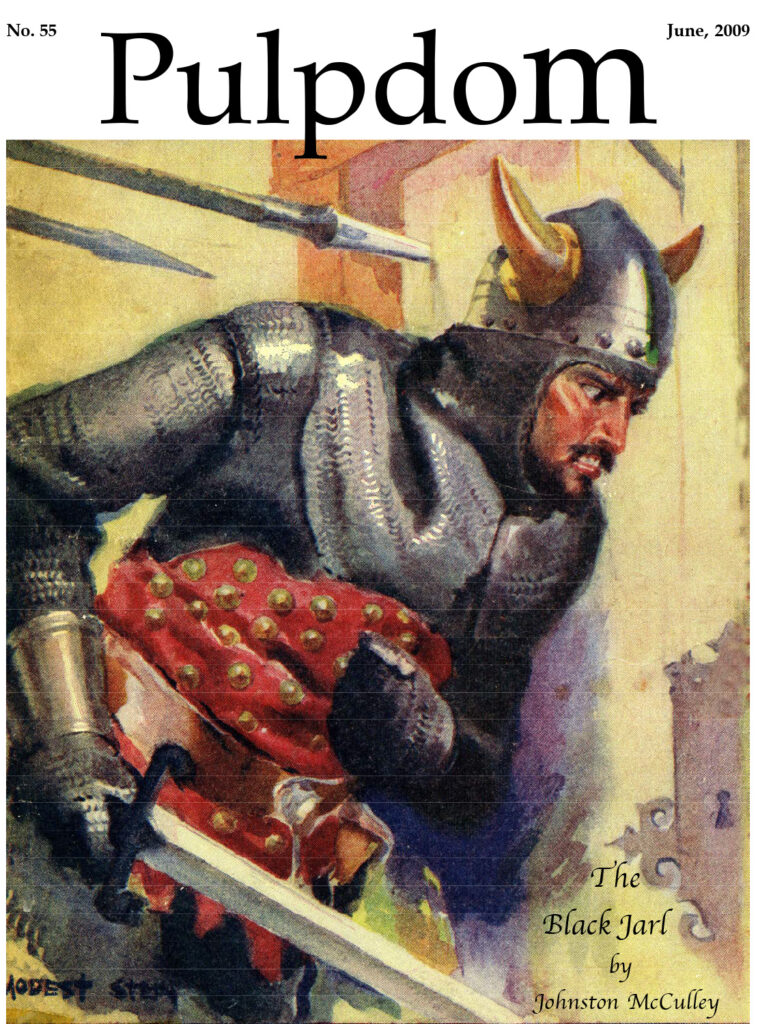 Finally, we get a focus on the sons of ERB — John Coleman Burroughs and Hulbert Burroughs — and some of their works together, with reviews of “The Man Without a World” (Thrilling Wonder Stories 1939), “The Lightning Men” (TWS 1940), “The Hybrid of Horro” (TWS 1940), and “The Bottom of the World” (Startling Stories 1941). These I’ve also reviewed here. Also, reviewed is “John Carter and the Giants of Mars” (Amazing Stories 1941), which was credited to ERB but is believed written by John Coleman, and Treasure of the Black Falcon (1967), a novel by John Coleman set on the bottom of the Atlantic.
Finally, we get a focus on the sons of ERB — John Coleman Burroughs and Hulbert Burroughs — and some of their works together, with reviews of “The Man Without a World” (Thrilling Wonder Stories 1939), “The Lightning Men” (TWS 1940), “The Hybrid of Horro” (TWS 1940), and “The Bottom of the World” (Startling Stories 1941). These I’ve also reviewed here. Also, reviewed is “John Carter and the Giants of Mars” (Amazing Stories 1941), which was credited to ERB but is believed written by John Coleman, and Treasure of the Black Falcon (1967), a novel by John Coleman set on the bottom of the Atlantic.
■ #55 (June 2009): Under a reprint of Modest Stern‘s cover for “The Black Jarl,” a Viking tale by Johnston McCulley, who is better known for Zorro, that first appeared in Argosy in 1923, we kick off the first of a three-part reprinting of this. I don’t think it has since been reprinted. Mike Taylor gives us an article on Zorro and his “kin,” basically other characters McCulley created that seem similar to Zorro: Don Peon (Argosy 1936), Senor Vulture (Argosy 1937), and several others. Some of these have been reprinted by Bold Venture Press, who has the rights to reprint Zorro. And we continue with The All-Story, now covering 1908.
■ #56 (July 2009): An N.C. Wyeth cover brings a focus on Ray Cummings, as Mike Taylor does a “re-examination.” Cummings is probably best known for “The Girl in the Golden Atom” (1919) and its sequel “The People of the Golden Atom” (1920), but he wrote a lot of other works. There are the “Scientific Club” sequence and the “Matter, Space, and Time” sequence. Too often, some are just a rehash of “The Girl.” Steeger Books, Armchair Fiction, and Pulpville Press have all reprinted works by him, and I hope to read and review these at some point.
■ #57 (October 2009): We get a Doc Savage cover by Walter Baumhofer with an article by Bill Garwood on Lester Dent and Doc Savage. Kurt Shoemaker examines Adventure for 1938, which includes several color covers.
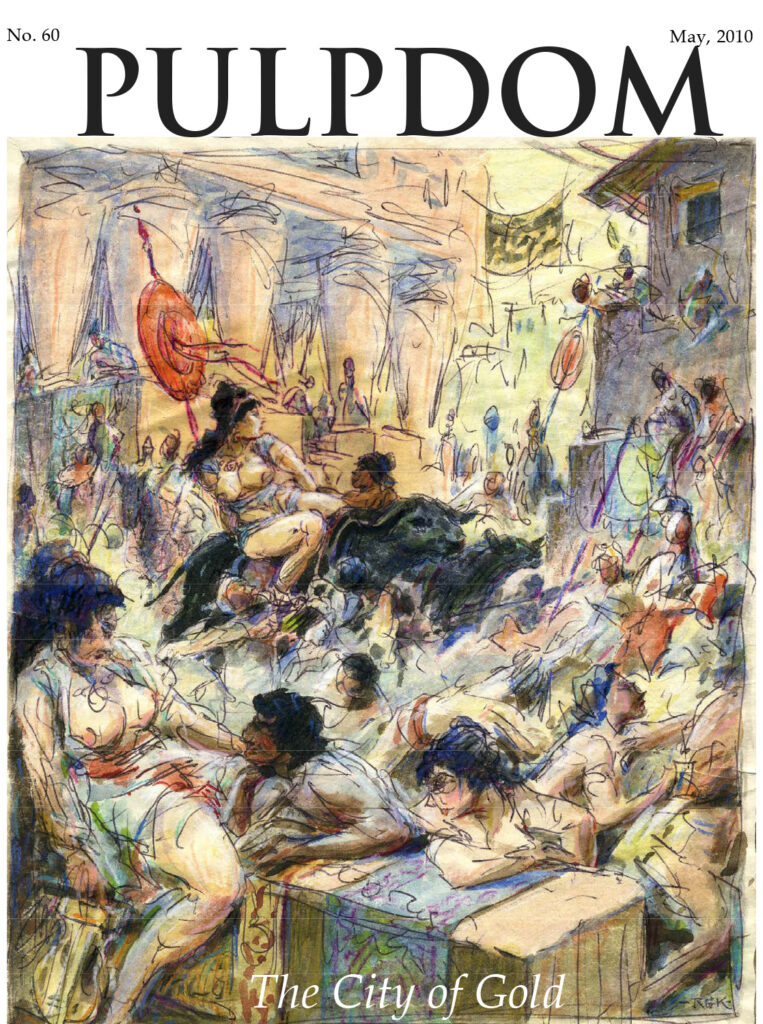 ■ #58 (December 2009): This time we get a cover by G.M. Farley of the Iron Mole burrowed up from the Earth, which ties to a reprint of “The Plunge of the ‘Knupfen’ ” by Leonard Grover from All-Story in 1909 (and later reprinted in Famous Fantastic Mysteries). It is the story of a man who uses a tunneling machine built by another to bore into the interior of the world, finding a hidden inhabited world. So this may have been an inspiration for Burroughs along with the many “hollow earth” stories that followed. This ties to an article by Mike Taylor examining many possible influences on Burroughs, noting where some of them were reprinted in prior issues of Pulpdom or its predecessor.
■ #58 (December 2009): This time we get a cover by G.M. Farley of the Iron Mole burrowed up from the Earth, which ties to a reprint of “The Plunge of the ‘Knupfen’ ” by Leonard Grover from All-Story in 1909 (and later reprinted in Famous Fantastic Mysteries). It is the story of a man who uses a tunneling machine built by another to bore into the interior of the world, finding a hidden inhabited world. So this may have been an inspiration for Burroughs along with the many “hollow earth” stories that followed. This ties to an article by Mike Taylor examining many possible influences on Burroughs, noting where some of them were reprinted in prior issues of Pulpdom or its predecessor.
Mike Taylor continues is examination of All-Story, now up to 1909, again with many color covers.
■ #59 (April 2010): The cover this time is a scene from Amtor (Burroughs’ Venus) by Jim Garrison. We get Mike Taylor’s next article on All-Story, covering 1910-11, again with many color covers. And there are two reprints from this period: “The Sky Police” by John A. Heffernan in 1910, and “A Place of Monsters” by Thomas P. Byron in 1911. The first is a “yellow menace” tale of air pirates being opposed by sky police. The second is a lost-world tale set in Central American with many terrifying beasts.
■ #60 (May 2010): We get a different cover with a rough sketch by Roy G. Krenkel for “A Festival in Crete.” This ties to the reprint this issue, the first of two parts of E.L. Bacon‘s “The City of Gold” that appeared in All-Story in 1911.
We get a couple of reviews, including one for James Francis Dwyer‘s The Lady With Feet of Gold (1937). Dwyer was covered in Pulpdom #41. There is a sequel to this story that appeared the following year, The City of Cobras. And lastly is a review of Jeff Canja‘s Popular Fiction Periodicals (2009).
Again, it’s another great set of issues. You can get PDFs of these from the publisher. Hardcopies are out there, but are too often overpriced. My next posting will be out at soon covering the rest of Pulpdom.

